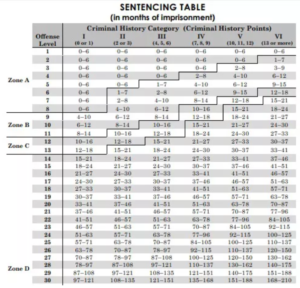The “college admission scandal” cases are complicated, and the pleadings are voluminous and more are being filed every day. I’ll try to summarize it all as accurately as possible: caution, though, that I am not offering any legal advice nor opinions, and defendants are innocent until proven guilty.
The US Attorney for Massachusetts has charged thirty three parents in two cases.
Case 19CR10117 – The Guilty Pleas
This case charges eleven parents with one count each of conspiracy to commit mail and wire fraud and honest services, mail and wire fraud under 18 USC 1349. Those parents/defendants have entered into plea agreements. The plea agreements are important, as they set out the agreed upon punishment for each defendant using the US Sentencing Guidelines. Those Guidelines are intended to provide “guideline ranges that specify an appropriate sentence for each class of convicted persons determined by coordinating the offense behavior categories with the offender characteristic categories.” https://www.ussc.gov/guidelines/2018-guidelines-manual/2018-chapter-1#NaN So there are two things the defendants needed to consider: their own criminal histories, if any, and the “offense level” of their crime, adjusted up for (in these cases) the amounts involved, and adjusted down for “acceptance of responsibility”. This gives an offense level of between 1 and 43, organized into four “zones”. The defendant’s criminal history is then considered, resulting in being placed into one of six criminal history categories. The result is a Sentencing Table with the seriousness of the crime on the Y axis and the seriousness of the criminal on the X axis. The court refers to, and can depart from, the ranges set out in the Table. A (partial) sentencing table (showing only the first 30 of the 43 offence levels) is seen here:
So … where are these eleven defendants on the Offense Level (Y) axis of the sentencing table? Each defendant is charged with the same offense, which carries an offense level of 7. The second factor is the amount involved in the conspiracy. Here, the base offense level of 7 was enhanced or increased by between 2 and 12:
Amount Range “Amount” Offense Level Base Offense Level Acceptance Total Number of Defendants
$250,000 – $500,000 +12 +7 -3 16 2
$150,000 – $250,000 +10 +7 -3 14 1
$95,000 – $150,000 +8 +7 -2 13 2
$40,000 – $95,000 +6 +7 -2 11 3
$15,000 – $40,000 +4 +7 -2 9 2
$6,500 – $15,000 +2 +7 -2 7 1
Based solely on the offense levels, and if all defendants are in criminal history category I (the first column), then one defendant falls within Zone A, five fall in Zone B, two fall in Zone C, and three fall in Zone D.
What did the plea agreements provide for?
Offense Level Number of Defendants Sentencing Range Plea Agreement[1]
16 2 21-27 months 15 months; $95,000 fine
14 1 15-21 months 12 months; $75,000 fine
13 2 12-18 months 12 months; $55,000 fine
11 3 8-14 months “at low end”; $40,000 fine
9 2 4-10 months “at low end”; $20,000 fine
7 1 0-6 months “within the range”; $9,500 fine
A few examples are warranted.
A husband and wife (the “Abbotts”) fell into offense level 13. The allegations are that they paid a total of $125,000 to have their daughter’s ACT and SAT test scores manipulated. That amount fell into the $95,000 to $150,000 range, which added 8 to the base level of 7, for a total of 15. Because that total (15) was below 16, they received credit of 2 for accepting responsibility. Their plea agreements are recommending to the court that they receive prison sentences of 12 months each, serve 12 months of supervised release, each pay $55,000 in fines, and pay restitution in an amount to be determined.
The actress Felicity Huffmann fell into offense level 9. The allegations are she paid “at least $15,000” to have her daughter’s SAR test scores manipulated. That amount – at least $15,000 – added 4 levels to her offense level (as opposed to adding 2 for $6,5000 to $15,000).
Case 19CR10080
In a separate case, a second superseding indictment filed on April 9, 2019, nineteen defendants have been charged with two counts each: conspiracy to commit mail and wire fraud and honest services, mail and wire fraud under 18 USC 1349 (as charged in the other indictment) and money laundering conspiracy under 18 USC 1956(h).[2]
Both the original criminal complaint and the second superseding indictment provide some detail on the money laundering “conspiracies”. I put “conspiracies” in quotes because there were no elaborate schemes to hide the origins of the payments, nor to really mask the identities of the recipients of the payments. Very simply, checks were written to a university or college sports department c/o the bribed official, or checks or wire transfers were made to a charitable organization operated by Rick Singer. The Government is alleging, and hopes to prove, that these simple transactions satisfy the elements of money laundering conspiracy. At least the Government will not have to unravel complex financial transactions involving multiple shell companies and payments mechanisms.
Conclusion
Eleven mothers and fathers have entered into plea agreements relating to a federal criminal charge of conspiracy to commit mail and wire fraud; nineteen more have been been charged with conspiracy to commit mail and wire fraud, and money laundering conspiracy. Ten of the eleven that have entered plea agreements have agreed to recommended federal prison sentences of between four and fifteen months; the eleventh has agreed to a recommended sentence of zero to six months. All eleven have agreed to fines ranging from $9,500 to $95,000, as well as restitution (to whom?) in amounts to be determined.
[1] In addition to the recommended sentences and fines, all defendants agreed to 12 months of supervised release and restitution to be set by the court
[2] In both indictments, the Government has brought forfeiture (18 USC 981(a)(1)) and money laundering forfeiture (18 USC 982(a)(1)) charges against the defendants.

